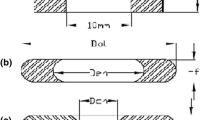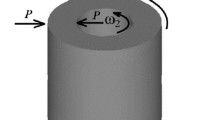Abstract
This paper uses finite element analysis to investigate the plastic deformation and metal flow of metal powder in open-die and closed-die rotating compression forming processes. In the closed-die rotating compression forming process, the effects of forming temperature, compression pressure, rotation speed, rotation lap number, and alternating rotation frequency on the relative density and effective strain distributions inside the product are discussed. In the open-die rotating compression forming process of powder materials, the top die is controlled by speed. The effects of alternating frequency on the rotating torque, axial load, bulging ratio, and relative density are discussed. A rotating compression machine is designed and manufactured. Experiments of rotating compression forming of aluminum alloy A1050 powder material are also conducted. The hardness distributions are measured and the metallographic microstructures are observed. The measured relative density and hardness distribution are compared with the simulation results to validate the finite element modelling of rotating compression forming of aluminum powder materials.


























Similar content being viewed by others

Data availability
Not applicable.
Code availability
Not applicable.
References
Hwang YM, Jhuang KS, Yu HC (2018) Finite element simulation of rotating compression forming. Mater Sci Forum 920:22–27
Nakayama N (2015) Development of functional material formed by powder metallurgy. J Japan Soc Technol Plast 56(651):270–274
Kamikawa N, Huang X, Tsuji N, Hansen N (2009) Strengthening mechanisms in nanostructured high-purity aluminum deformed to high strain and annealed. Acta Mater 57:4198–4208
Zhilyaev AP, Lee S, Nurislamova GV, Valiev RZ, Langdon TG (2001) Microhardness and microstructural evolution in pure nickel during high-pressure torsion. Scripta Mater 44:2753–2758
Isik M, Niinomi M, Cho K, Nakai M, Liu H, Yilmazer H, Horita Z, Sato S, Narushima T (2016) Microstructural evolution and mechanical properties of biomedical Co–Cr–Mo alloy subjected to high-pressure torsion. J Mech Behav Biomed Mater 59:226–235
Tsutsui K, Kume Y, Kobashi M, Kanetake N (2009) Effect of processing temperature on microstructure of AZ61 magnesium alloy produced by compressive torsion processing. J Japan Institute Light Metals 59(1):35–40
Kume Y, Kobashi M, Kanetake N (2007) Effect of processing temperature and specimen diameter on grain refinement with compressive torsion processing. J Japan Soc Technol Plast 48(562):1007–1011
Takahashi T, Kume Y, Kobashi M, Kanetake N (2009) Solid state recycling of aluminum machined chip wastes by compressive torsion processing. J Japan Institute Light Metals 59(7):354–358
Matsumoto R, Kou J, Utsunomiya H (2017) Reduction in axial forging load by low-frequency torsional oscillation in cold upsetting. Int J Adv Manuf Technol 93:933–943
Kulagin R, Zhao Y, Beygelzimer Y, Toth LS, Shtern M (2017) Modeling strain and density distributions during high-pressure torsion of pre-compacted powder materials. Mater Res Lett 5(3):179–186
Tzou GY, Hwang YM, Pan SC (2017) Comparisons of compression characteristics in compression forming of porous cylinder based on slab method and finite element method under constant shear friction, MATEC Web of Conferences. Int Conf Precision Machinery and Manufacturing Technology (ICPMMT) 123(2):1–7
Matsumoto R, Tanaka S, Utsunomiya H (2022) Enhancement of plastic flow in lateral direction by torsional oscillation in upsetting and lateral extrusion. J Mater Proc Technol 299:117369
Koskilinna JO, Linnolahti M, Pakkanen TA (2006) Friction coefficient for hexagonal boron nitride surfaces from ab initio calculations. Tribol Lett 24:37–41
Green R (1972) A plasticity theory for porous solids. Int J Mech Sci 14(4):215–224
Hwang YM, Yu HC, Yin SK (2019) Study of hot rotating compression forming of aluminum powder. Int Conf Adv Mater Proc Technol (AMPT2019), paper No.:WB1–4, Taipei, Taiwan, 1–7
Acknowledgements
The authors would like to extend their thanks to the Ministry of Science and Technology of the Republic of China under Grant no. MOST 109-2221-E-110-001-MY3. The advice and financial support of MOST are greatly acknowledged.
Funding
From Ministry of Science and Technology of the Republic of China under Grant no. MOST 109–2221-E-110–001-MY3.
Author information
Authors and Affiliations
Contributions
Conceptualization, Y.-M. H. and S.-K. Y.; formal analysis, Y.-M. H. and S.-K. Y.; experiments, H.-C. Y. And Y.-H. T.; writing—review and editing, Y.-M. H.
Corresponding author
Ethics declarations
Ethics approval
Not applicable.
Consent for publication
All authors have read and agreed to the published version of the manuscript.
Conflict of interest
The authors declare no competing interests.
Additional information
Publisher's Note
Springer Nature remains neutral with regard to jurisdictional claims in published maps and institutional affiliations.
Rights and permissions
Springer Nature or its licensor holds exclusive rights to this article under a publishing agreement with the author(s) or other rightsholder(s); author self-archiving of the accepted manuscript version of this article is solely governed by the terms of such publishing agreement and applicable law.
About this article
Cite this article
Hwang, YM., Yin, SK., Yu, HC. et al. Finite element analysis of rotating compression forming of powder materials. Int J Adv Manuf Technol 123, 793–807 (2022). https://doi.org/10.1007/s00170-022-10218-y
Received:
Accepted:
Published:
Issue Date:
DOI: https://doi.org/10.1007/s00170-022-10218-y



